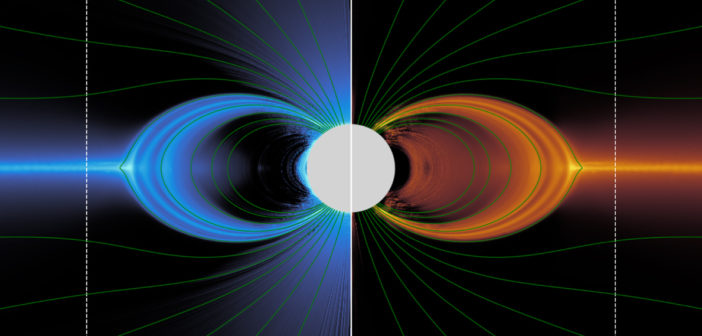
Top row, left to right: simulated electron, positron, and ion charge densities. Bottom row, left to right: simulated electron, positron, and ion contributions to the overall electric current. Click for high-resolution version. [Hu and Beloborodov 2022]
When a massive star expires, its core can collapse into a rapidly spinning, city-sized sphere of neutrons with a powerful magnetic field — a pulsar. Pulsars get their name from the beams of radio waves they emit, which we observe as pulses of emission as the beam sweeps across our field of view. In a new publication, Rui Hu (Columbia University) and
Andrei Beloborodov (Columbia University and Max Planck Institute for Astrophysics, Germany) used simulations to explore the charged particle environment near a pulsar, where fierce electric fields siphon electrons and their positively charged twins, positrons, from the pulsar’s blazing surface. The image above shows the simulated charge densities for electrons (left side) and positrons (right side). The full version of the image, shown to the right, includes the results for ions as well as the contribution of each species of charged particle to the overall electric current. These simulations by Hu and
Beloborodov investigate where and how particles are accelerated, which is key to understanding how pulsars produce their radio emission and interpreting observed radio pulses. To learn more about modeling a pulsar’s particle environment, be sure to check out the full article below!
Citation
“Axisymmetric Pulsar Magnetosphere Revisited,” Rui Hu and Andrei M. Beloborodov 2022 ApJ 939 42. doi:10.3847/1538-4357/ac961d


